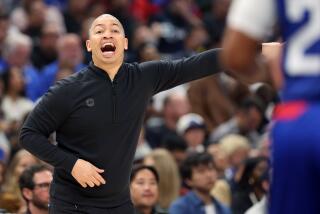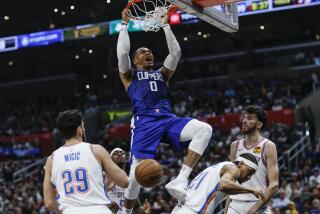Smith Knows His Stuff on the Court : Pro basketball: Clippers’ versatile second-year forward keeps getting better and better, but isn’t much of a fan.
- Share via
Charles Smith, the best basketball player who knows nothing about basketball, is flunking a pop quiz about the sport that has made him famous, not to mention a millionaire. And he realizes it.
“I don’t know the names of all the conferences and divisions,” the Clippers’ second-year forward says. “I know we play in the Pacific Division and the Western Conference. What else is there?”
He pauses.
“The Midwest in the West, and the Central in the East,” Smith continues. “And one more.”
He pauses again, searching to avoid having to explain why someone who is regarded as one of the best young players in the game can’t even discuss that game with many fans. Stumped.
“Atlantic Division,” the inquisitor offers up.
“Atlantic!” Smith counters quickly, snapping his finger.
Chagrined, he smiles. But he is not embarrassed at a lack of knowledge, admitting to being a basketball player but not a basketball fan--semantics that cut to the heart of the man.
“When Charles comes home, he still plays with the kids on the courts,” his father, Charles D. Smith, says in Bridgeport, Conn. “But that’s different. When he was at Pitt, I would tape every game I could see on TV. When Charles came home for a vacation, I would play it back so he could watch. He’d say, ‘Dad, when I come home I want to relax.’ The only thing he wanted to see was something like when Jerome Lane broke that backboard with a dunk. His attitude is, he plays it, he knows he does well at it, but basketball is not a 24-hour conversation piece.”
Give Smith a test on the court, however, and he passes practically every other night of the week like a guy with a cheat sheet tucked in his socks. His grades last season were certainly honor-roll material: averages of 16.3 points and 6.6 rebounds a game, the first Clipper since Terry Cummings in 1982-83 to be named to the all-rookie team.
All that has changed in his second season is an escalation of numbers and reputation: 21 points and 6.9 rebounds, heading into tonight’s game against the Lakers at the Sports Arena. If the scoring pace holds for the final 12 games of the season, he will finish with the highest Clipper average since Derek Smith’s 22.1 in 1984-85.
“My players tell me he’s one of the most difficult guys around to guard,” Minnesota Coach Bill Musselman said.
“There’s not too many people who can perform so well in the low post and step out and shoot from 18 or 19 feet, handle the ball, run the fast break and play defense, inside and outside,” adds New York assistant Jeff Van Gundy, also an assistant at Providence while Smith was a force at Pitt. “He’s one of the most versatile players in the league.”
It’s the versatility that makes Smith, 24, unique. Play him at power forward or center, and he will use quickness and the ability to shoot outside. Put a smaller man on him, and the 6-foot-10, 230-pound player will post up.
That ability started in high school, as did his well-rounded, non-basketball life: chess club, football team as a freshman and sophomore, yearbook staff, library club. The Smiths of Bridgeport were not a sports-minded family, and Charles never had a favorite player or a favorite team. He was in the heart of the NBA--45 minutes to New York City, three hours from Boston--and barely followed the game.
Part of that might have been because he wasn’t much good, barely making the freshman team. At 5-10, he was a guard, which, it turned out, helped him to develop the shooting and dribbling skills that remain. Soon, he started growing, in size and stature.
“I don’t remember saying I’m 6 feet or 6-1 or 6-2,” Smith recalls. “It was like I was 5-11 and then I’m 6-7.”
Just as quickly, he developed into a top prospect. During summers, he would stay at Rod Strickland’s house for a week at a time to play on the outdoor courts of New York. Warren Harding High got national recognition, and Smith got scholarship offers. He chose Pittsburgh over Villanova.
“I wanted to be one of the main players who helped create a program,” he said. “It was like coming to the Clippers. Nobody knew anything about Pitt. It was a football school.”
Not for long. With Smith and Lane, the former NCAA rebounding champion who now plays for the Denver Nuggets, the Panthers rose to prominence. Smith was named Big East player of the year, but picked up the label as a soft player inside. He blames Pitt Coach Paul Evans, who took over the program after Smith’s sophomore year.
As much as Smith dislikes his former coach, Evans did increase his versatility, or at least marketability to the pros. The issue was always center or forward. Smith wanted to work the perimeter more, to exploit his shooting. Evans, having just come from the U.S. Naval Academy, wanted more of a post player and constantly held up David Robinson as Example A of how much better the pros would look upon Smith if he could play center.
“If I didn’t know David,” Smith now says, “David would have been my enemy by the time I left there.”
On draft day, Danny Manning went first to the Clippers, and Smith was picked by the Philadelphia 76ers at No. 3. Coincidentally, the two had gone out to dinner the night before the proceedings in New York with friends and another top prospect, Gary Grant of Michigan. After Seattle used the 15th choice on Grant, a three-way trade was announced.
All became Clippers.
On a team devastated by injuries, Smith has been one of the few constants. Although not the rebounder he would like to be, Smith became the team’s offensive star after Ron Harper’s injury. He’ll work on the inside game, but wisely will not fall into the trap of trying to come off like a normal 6-10 power player.
“Versatility is the key,” the Knicks’ Van Gundy says. “I don’t think you want to change one of his strengths. He’s so good because of exactly what he is.”
And he will, all concerned say, get better with time. A spot on the all-star team is a goal of Smith’s.
He knows he is good enough. He just doesn’t know the statistics of the players he would have to beat out.
This is nothing new, of course. The pop quiz went to college basketball, and the man they call “Fluid,” a nickname to describe his style of play, is laboring again: How many of the last NCAA champions can you name?
“Let’s see,” Smith begins. “Last year, it was Indiana beating Syracuse when Keith Smart hit the winning shot.”
Pause.
“No, wait. That was my senior year.”
Pause.
“No, that was my junior year. My senior year, it was Danny and them (at Kansas).”
So what about last season?
Stumped.
“Don’t tell me,” he says.
Someone finally did. After all, the Clippers had a game the next night.
Michigan.
“Damn,” Smith says sarcastically. “That’s what I thought.”
More to Read
Go beyond the scoreboard
Get the latest on L.A.'s teams in the daily Sports Report newsletter.
You may occasionally receive promotional content from the Los Angeles Times.






